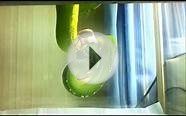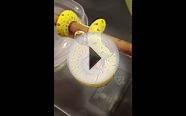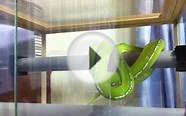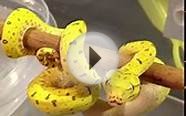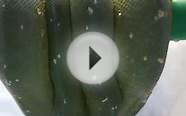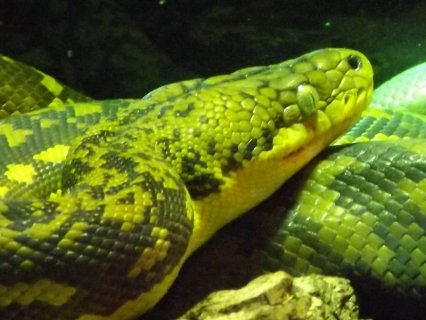
Python information for Kids
Habitat:
Rain forest, grassland and savanna, woodland, and swampsFood:
Rodents, birds, lizards, monkeys, pigs, or antelope, depending on the size of the snakeSize:
23 inches to 33 feet, depending on the speciesBabies:
Hatch from eggs and take care of themselves from the startPythons have fangs, but do not produce venom.
The Big Squeeze
A hungry python tastes the air with its tongue to smell if preyNoun: An animal that is hunted as food by another animal. Verb: To attempt to take an animal for food. is nearby. Special temperature-sensing pits on its face tells the snakeAn animal with a long, scaly body and no arms, legs, or wings. Snakes have backbones and are cold-blooded. if a warm-bloodedAn animal whose body temperature stays fairly constant, no matter what the temperature of the air around it. animalAny living thing that is not a plant. Most animals can move about freely. All use plants or other animals as food. All have sensory organs. is nearby. When its preyNoun: An animal that is hunted as food by another animal. Verb: To attempt to take an animal for food. is close enough, the python grabs it with its teeth, then quickly wraps its body around the victim and squeezes. The snakeAn animal with a long, scaly body and no arms, legs, or wings. Snakes have backbones and are cold-blooded. doesn't actually crush the preyNoun: An animal that is hunted as food by another animal. Verb: To attempt to take an animal for food. and break its bones, though. Instead, it squeezes tightly so that the preyNoun: An animal that is hunted as food by another animal. Verb: To attempt to take an animal for food. animalAny living thing that is not a plant. Most animals can move about freely. All use plants or other animals as food. All have sensory organs. can’t breath and it suffocates. Then the python unhinges its jaws so it can open its mouth wide enough to swallow the food whole.
Some people think that pythons launch themselves out of trees onto unsuspecting animals below, but that's not a good move. Diving out of a tree like that could cause serious injury to the snakeAn animal with a long, scaly body and no arms, legs, or wings. Snakes have backbones and are cold-blooded., especially a big one. In fact, most big pythons stay on the ground for that very reason. Swimming is another story! Many pythons are excellent swimmers and spend a lot of time in the water. One of their ambushA method of attack. The attacker hides from its prey until the prey gets close enough to attack, surprising the prey. Tigers, pythons, and rattlesnakes are examples of ambush hunters. techniques for catching food is to lie submerged in a stream or slow-moving river with only their heads above the surface, waiting for a birdAn animal that has wings and is covered with feathers. Birds have a backbone, are warm-blooded, produce young from eggs, and walk on their two legs. Most can fly. or small mammalA warm-blooded animal with a backbone that breathes air, and has at least some hair at some point during its life. The females have glands that produce milk, which they feed to their young. to come to the water’s edge.
You might also like
